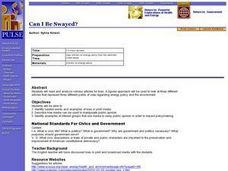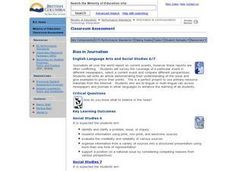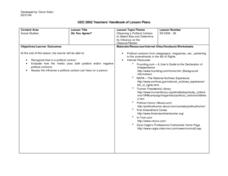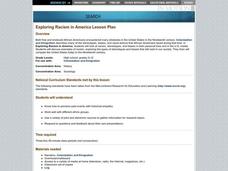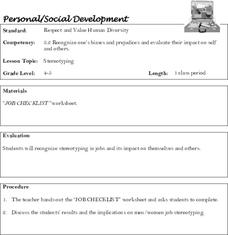Curated OER
Research Methods
Students identify the strengths and weaknesses of various family forms: living alone, couples without children, couples with children, divorced adults, traditional families, single-parent families, blended families, etc. They assess...
Curated OER
Suspect Sources at the Republican Debate
Learners review statements made during a 2007 Republican presidential for factual references. They research the statements for accuracy using internet resources. Students also examine the stated purpose of the websites used to fact check...
Curated OER
No Bias Allowed
Students differentiate graphical representations looking for the bias. They use a systematic process in order to solve problems. Students explain how a problem is solved and the steps involved. Even deeper than this is giving the...
Curated OER
How Can Librarians Work To Eliminate Cultural Bias In The Organization Of Information?
Students explore the complexities of organizing information and to support librarians in developing strategies for reducing cultural bias. Students extend strategies to help raise solutions. Students list a variety of definitions on bias...
Curated OER
Can You Detect Bias?
Eleventh graders recognize some, but not all ethical processes (e.g., independent verification, clarifying assumptions, disclosing conflicts of interest) that shape scientific endeavors. Students build awareness of how various sources...
Curated OER
Can I Be Swayed?
Students identify loaded words and examples of bias in print media. They describe how media can be used to manipulate public opinion. Students identify examples of interest groups that use media to sway public opinion in order to impact...
Curated OER
Bias in Journalism
Pupils evaluate the credibility and reliability of various sources. Students survey the coverage of a particular event in different newspapers, select a current event and compare different perspectives. They write an article...
Curated OER
Mr. Lincoln's Way
Young scholars read the book, Mr. Lincoln's Way by Patricia Polacco, They discuss racism and discrimination. They draw a bird and write a paragraph discussing what makes their bird special and unique.
Curated OER
Do You Agree?
Students recognize bias in a political cartoon, evaluate how the media uses both positive and/or negative political cartoons, and assess the influence a political cartoon can have on a person.
Curated OER
Bias, Prejudice and Propaganda
Twelfth graders examine bias, prejudeice, and propaganda in reading selections. They view commercials and print ads, discuss how the advertisers are trying to convince them of something, and keep a commercial journal.
Curated OER
Women's Brains
Students experience an example of bias in science dealing with women and gender.
Curated OER
Interactive Duty
Students consider the role of multimedia news features. They analyze the New York Times coverage of the president's State of the Union address.
Curated OER
Bias vs. Perspective: An Inevitable Aspect of Journalism?
Students explore the types of media that U.S. teens prefer the ways in which viewers identify and account for journalistic bias. They explore the ways in which media shapes one's opinion or affects their judgment.
Curated OER
Mapping Data Made Manageable
Students explore how to select unbiased random samples as they choose report data to include on maps. They propose methods for choosing random numbers and discuss their advantages and disadvantages. They consider bias in science.
Curated OER
Bias Sampling
Students demonstrate how the results of a poll or other scientific study can be biased by selecting special types of people to respond or by asking only certain questions.
Curated OER
What Is History?
Students process a variety of information on the reasons for different interpretations of history.
Curated OER
Human Rights
Students explore the importance of laws and the need to speak up against wrong doing and how to bring change in society and in the law. They discuss the needs and concerns of others. Students explore the concept of bias and prejudice....
Curated OER
Defining Moments: Analyzing Data
Students create an annotated bibliography on writings related to Japanese internment and analyze the writings for possible bias. They view a video on the Korematsu Internment case and use the internet to find print and non-print sources...
Curated OER
A Snapshot in Time
Students state the main ideas of the article. They create questions to clarify the meaning of the article and to help explain the ideas. Students cite words or phrases that reveal a bias the author may have.
Curated OER
Reducing Bias
Students begin their examination on the conflict in the Middle East. Before beginning, they complete a survey and discuss their answers to hopefully reduce their bias about the region. They examine the problem in the Middle East from the...
Curated OER
Exploring Racism in America
Students compare racism today to racism that existed during the nineteenth century. As a field research project, students individually keep track of examples of racism, biases, and stereotypes illustrated throughout the US media over a...
Curated OER
Stonewall and Beyond:
Students examine issues that surround the quest for gay/lesbian equal rights, explore bias and negative stereotyping in the media and their effect on how gays and lesbians are treated, examine their own biases, and express their opinions...
Curated OER
Stereotyping
Students study how stereotyping in jobs impacts themselves and others. They complete a worksheet about the implications of stereotyping and discuss it.







